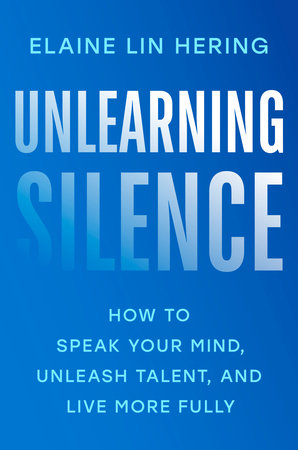READERS GUIDE
BEFORE
1. Who we are shapes how we engage with a book. What identities do you currently hold? Consider gender, race, family background, relationship status, education, ability and others.
2. Why are you reading this book? Are you choosing to read it or is someone making you? What are you hoping to learn or explore as you read this book?
DURING
1. In the introduction, Elaine offers multiple definitions of silence. What is your own understanding of silence? What messages have you received about silence? How do those messages apply to you versus to people with different identities?
2. What is your reaction to the idea that you have silenced other people? What thoughts and feelings come up for you? Noticing your own reaction to having silenced people is a starting point for figuring out what you want to do going forward to increase the likelihood you support rather than silence people with your actions.
3. Elaine presents us with various scenarios where people stay silent (work, family, friendships etc). In what contexts are you most likely to stay silent? In what contexts are you most likely to use your voice? What are the factors that most influence your decision to choose silence over voice? Consider who, what, where, when, and why.
4. Chapter 2 explores the things that are problematic with silence. Which of these have you experienced? What coping mechanisms have you employed to help you navigate the negative impacts of silence? What are the pros and cons of the things you have tried?
5. In Chapter 3, Elaine names two biases that impact our perception of whether speaking up makes sense. How do you see these biases play out in your own calculations?
6. Of the reasons that Elaine provided in Chapter 4 about why we silence ourselves, which do you relate to? If they don’t resonate with you, how might they impact the people you are communicating with?
7. Which level of directness do you tend use? What level of directness does your culture expect of you? What level of directness is valued in your family, on your team, or within your organization? Discuss with other people in your family, team, or organization to see how your experiences and interpretations compare.
8. One of the ways we silence people is by saying we want their input when we really don’t. Where have you felt pressure to invite people’s perspective into the mix? If you were to more accurately sort stakeholders into the three buckets (decide, consult, inform), who would be in which bucket?
9. We are bombarded with critical feedback all the time, and the negative inputs can strike deeply. Chapter 6 invites us to balance the inputs by inviting in voices who will say the things we need to hear. Whose voice do you need to invite into your mix? Will you invite a specific person you already know to share that perspective? Or who might you add to the list of podcasts you listen to, people you follow, or books you read to get that perspective?
10. In Chapter 6, Elaine encourages us to regularly recalibrate our understanding of our own voices. What does your voice sound like now? What did it used to sound like 5 years ago? 10 years ago? What changes do you notice? Are those the changes you desire or intend?
11. Substance, relationship, and process are three levers for using our voice. Which of these levers do you naturally focus on? Which of these levers might you actively experiment with using?
12. In Chapter 8, Elaine provides us with a framework for speaking up. Which of these anchors do you already utilize? Which of these anchors do you find the hardest to integrate into your practice?
13. If we don’t design our communication patterns, they typically default to serve the people with the most existing power. What communication mediums and practices make it easiest for you to use your voice? If you manage people, what communication mediums and practices make it easiest for them to use their voice? If you don’t know, ask now!
14. Systemic silence can seem overwhelming. But each of us doing a part makes change possible. Of the five things Elaine outlines in the “What Can I Do?” part of in Chapter 10, which seems most doable to you? Which will you try?
AFTER
1. What resonated most with you from the book? What did you struggle with?
2. What did you notice about your own relationship with silence in the process of reading? How do you want your relationship with silence to evolve? What steps might you take to make that evolution a reality?
3. What experiments will you try in the next three weeks?
a. What do you worry about with trying these experiments?
b. How can the people around you support your experiments?
c. What conversations do you need to have with them to invite their support?
4. What questions still remain for you about unlearning silence? Send your questions to hello@elainelinhering.com. We can’t guarantee personalized responses to every question, but your questions help inform the content we continue to create.
5. Find your favorite quote from the book. Share it on social media, tag @elainelinhering and use #UnlearningSilence
SIX WAYS TO CONTINUE TO SUPPORT 1. Visit www.elainelinhering.com for resources, tools, and downloads to help you and your team use your voices.
2. Talk about the book on social media using #UnlearningSilence.
3. Leave a review of the book on bookseller websites.
4. Buy the book for a friend.
5. Contact your local library and suggest they purchase the book.
6. Sign up for monthly communication tips at https://hello.elainelinhering.com/newsletter
www.unlearningsilence.com
Linkedin / Instagram @elainelinhering

